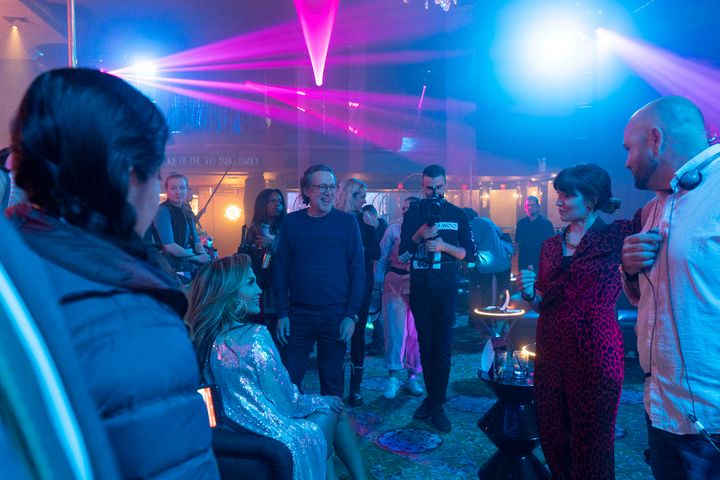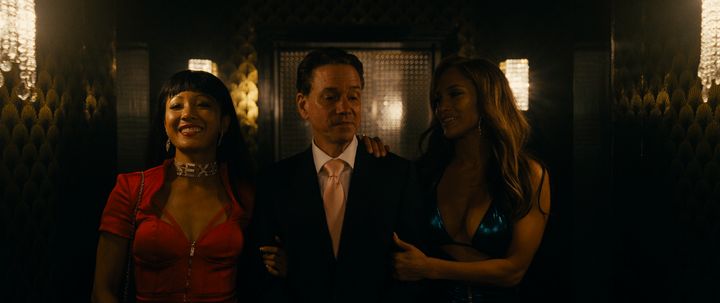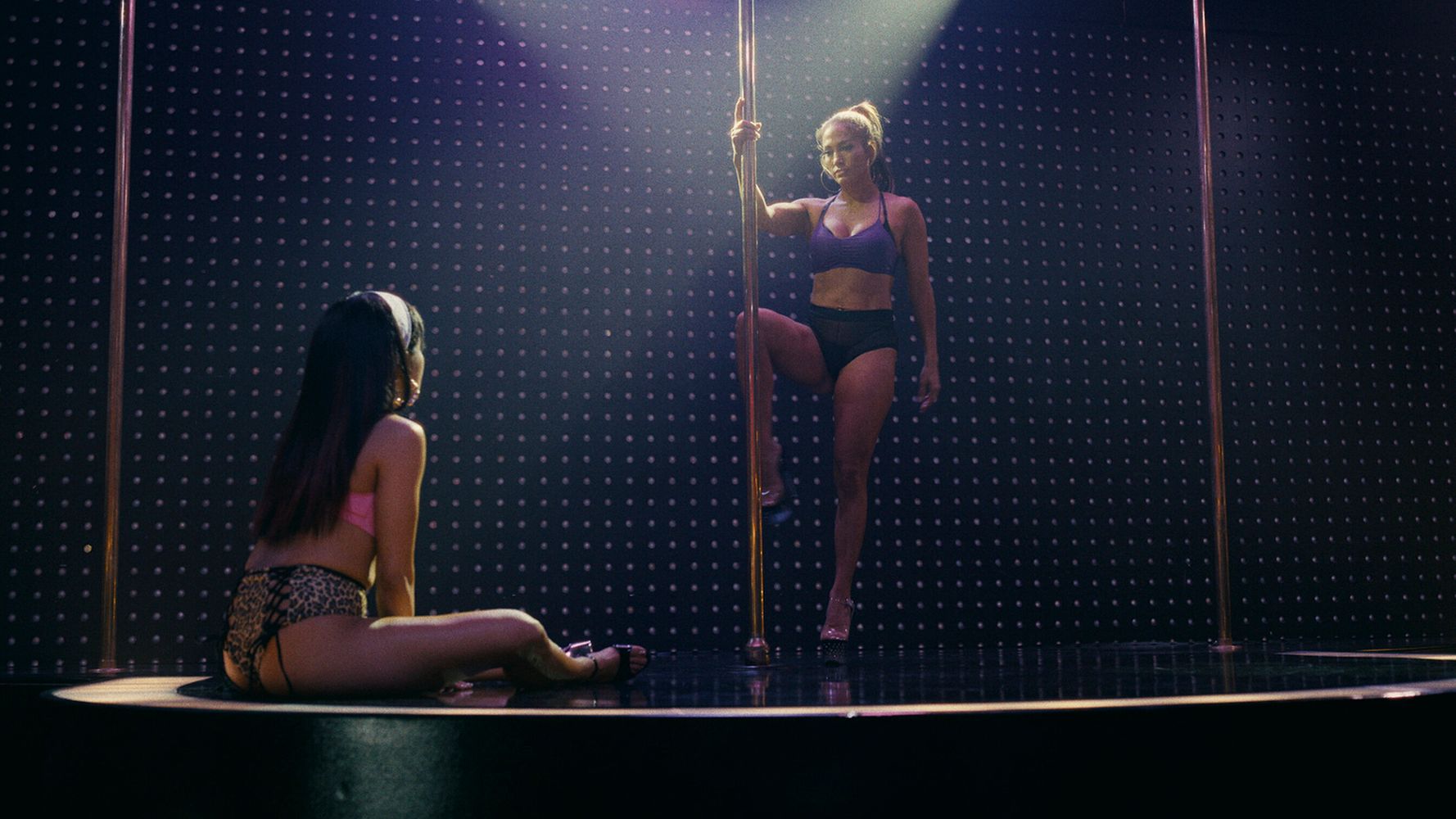[ad_1]
There’s no one best scene in “Hustlers.” Can you really say that Usher’s strip-club strut tops Jennifer Lopez dancing to Fiona Apple’s “Criminal”? How about J.Lo and Constance Wu passed out on a kitchen floor after testing the potent blend of ketamine and MDMA they’ll serve to unsuspecting male clients? Cardi B’s lap routine? Lili Reinhart vomiting en route to jail?
Everything in Lorene Scafaria’s crime romp — based on events chronicled in a 2015 New York magazine story — is a delight. What starts as a pop pageant about New York strippers earning their wealth becomes a smart rhapsody about a cabal of clever women defrauding patrons in order to weather the 2008 economic crash.
When veteran dancer Ramona (Lopez) takes struggling rookie Destiny (Wu) under her wing, the pair emerge an unrelenting duo. But first, Ramona has to teach Destiny all the right moves. Which meant Lopez had to learn them, too.
Even though she’s a trained performer with years of touring to her name, Lopez spent almost four months working with a pole-dancing instructor. Most of her prep went into a mind-boggling scene that finds Ramona demonstrating for Destiny a series of standard pole maneuvers, all requiring intense leg and ab prowess. Reciting terminology that is clearly second nature to her, Ramona shows off about a dozen positions: the knee hook, the carousel, the butterfly, the Peter Pan, the tabletop, the martini. Her instructions are tantamount to the training-sequence trope that’s common in underdog films such as “Rocky,” “The Karate Kid” and “Mulan.”
“We have to present this like a sports movie and highlight the athleticism of it and the strength and the power of it,” Scarfaria said last week over coffee at a Manhattan hotel.

Johanna Sapakie, a choreographer who has a decade of aerial experience in Cirque du Soleil, gave Lopez a “crash course” in “all things pole” to perfect the “Criminal” arrangement and Ramona’s subsequent lecture. In hourlong sessions at Lopez’s homes, Lopez learned how to employ upper-body fortitude to hold herself on the pole and twirl upside down. They’re hardly beginner moves, and Lopez had to seem like a virtuoso. The student needed to become the teacher. At the start of their collaboration, Sapakie told Lopez a version of what Ramona tells Destiny after the latter voices self-doubt: “Every woman can do this.”
“I wanted something that clearly indicated that this is a woman that’s been doing this a long time,” Sapakie said. “When we started working on it, it was very challenging. And watching the playback on the monitors of her doing it [during the shoot], you just see this smile on her face when she’s upside down holding on with just her hand. Literally, there’s just this glorious smile on her face. It can’t be faked.”
Scafaria, whose previous credits include “The Meddler” and “Seeking a Friend for the End of the World,” wrote the names of the pole positions into the script. They don’t correspond to the technical terms adopted by competitive pole dancers and the corresponding fitness movement because in strip clubs women often invent their own lingo. Since the movie’s lucrative opening weekend, Sapakie has read online forums in which pole veterans assume the movie is misidentifying common nomenclature. In actuality, Scafaria’s intent was to remain authentic to the strip-club experience.
“And every city has a different dance style,” said Jacqueline Frances (aka Jacq the Stripper), who consulted on the project. “Every club you go to, there’s a different groove, there’s a different move, there’s a different lap dance. And depending on what kind of pole there is and where it is and what kind of literal hardware you have to work with, the whole style changes. There’s a chin-up bar at one of the clubs in Midtown, so girls are there doing chin-ups. It’s just like, ‘What do ya got? I need to make money. Let’s make it creative.’ It’s all about being resourceful, which is what this whole movie is about.”
The coaching scene conveys control, a motif introduced in the Janet Jackson song that opens the film. That applies to Ramona and to Lopez herself. At 50 years old, Lopez is enjoying her fiercest role since 1998’s “Out of Sight,” underscoring a bewitching screen presence that never went away. Ramona possesses an expert ability to sell her personality, and so does the woman who inhabits her. (Try watching “The Wedding Planner” without swooning for Lopez. You can’t.) Ramona instructs Destiny how to use her body so authority rests with her instead of the men tossing dollar bills onto the stage. Once she’s confident in her skills, Destiny can manipulate customers into spending more.

The scene’s flair lies in Lopez’s dazzle and the surprising music that guides it. instead of a pumped-up anthem, we hear a graceful Chopin étude. Ramona’s skills are as much art as they are recreation, ballet and calisthenics all in one.
Chopin appears a few times in “Hustlers,” contrasting a soundtrack that will be remembered for its Janet Jackson, Britney Spears and Lorde classics. Because pop music is sometimes mistaken as a medium that lacks substance, Scafaria’s use of Chopin adds an ironic edge to the proceedings. An esteemed 19th-century composer couldn’t have anticipated that his work would one day score a pole-dancing tutorial and a mosaic celebrating strippers’ camaraderie, but why shouldn’t it? Scafaria included the classical numbers in the script and even pitched the movie to studio executives using a montage featuring actual strippers shimmying to Chopin.
“Those specific studies are so hard to play,” she said. “That’s why they are what they are. They’re these arpeggios that require so much flexibility and dexterity that nobody can play them, truly. We really had to track down this unbelievable pianist whose recordings I had been editing to for years. Thank God we got the rights to that because you can’t even just get, like, the greatest Chopin pianist of all time who’s won all these awards. You can’t just sit down and bust one of those out.”
Ramona and Destiny’s teamwork is fruitful, letting them fleece Wall Street bigwigs whose swollen pocketbooks sometimes come at the expense of middle-class Americans. And when the women join forces again post-recession, they find other ways to max out men’s credit cards ― at least until those efforts turn, well, criminal. Call it entrepreneurial, call it abuse, call it whatever you like.
“I don’t think people look at strippers doing their jobs and even think that they’re earning a living,” Scafaria said. “It’s about all the power dynamics that we are all up against. There are so many moments that we’re out of control, or so many moments that we want to feel like we’re in control. The value system is pretty broken, what women and men are valued for. I wanted to talk about all of that. The theme of control just seems to seep into every other aspect of our culture. Every headline, I think, is actually a trickle down of that broken value system.”
Perhaps the impact of “Hustlers” is best summarized by Ramona’s final words, delivered to a journalist (Julia Stiles) documenting the fallout from her swindling scheme: “This whole country is a strip club. You’ve got people tossing the money and people doing the dance.” In two succinct sentences, Ramona digests the exploits of modern capitalism, gendered and otherwise.
“The rules of the club are the rules of the world,” Scarfaia said. “In this place, there’s an exchange of goods, there’s a supply and demand. Obviously, it’s also a crime drama. Women doing bad things seems to turn people off sometimes, so I really wanted to tell a story with empathy and authenticity, at least, and leave it up to the audiences to see what it does to them. It may make them feel uncomfortable. It may make them feel overjoyed. Who am I to judge?”
REAL LIFE. REAL NEWS. REAL VOICES.
Help us tell more of the stories that matter from voices that too often remain unheard.
[ad_2]
Source link

